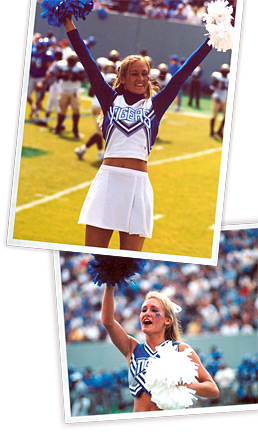Today, highly demanding acrobatic moves have become the norm, experts say. National competitions have upped the ante, by fomenting a "can you top this" attitude that pushes kids to do even riskier stunts.
As a result, their jumps, splits, and acrobatic tumbles have become to cheerleaders what the blindside hits, collisions and flying tackles are to the football players out on the field. The jolts to their bodies are serious.
But while injuries have made cheerleading the most dangerous sport for young American women, experts say that the risk and severity of injury can be kept to a minimum with chiropractic care. Chiropractors identify injuries early and properly manage them before they progress to something more serious, which is the key to people like Parks who has had to ensure her body heals properly.
Natural Healing
 Krista Parks (in photo) was a University of Memphis cheerleader in 2003 when an ambitious front-flip maneuver during practice turned disastrous, ending her career and necessitating years of rehabilitation.
With cheerleading calling for ever-higher degrees of athleticism, chiropractors say they are able to provide a unique understanding of the rigorous training and physical toll that the sport has on the body, unlike any other type of physician.
Krista Parks (in photo) was a University of Memphis cheerleader in 2003 when an ambitious front-flip maneuver during practice turned disastrous, ending her career and necessitating years of rehabilitation.
With cheerleading calling for ever-higher degrees of athleticism, chiropractors say they are able to provide a unique understanding of the rigorous training and physical toll that the sport has on the body, unlike any other type of physician.
"Doctors of chiropractic are the only healthcare professionals who specialize in the process of correcting spinal misalignments with adjustments," said Dr. Steve Goninan, a chiropractor at Integrity Chiropractic in Georgia. "These adjustments re-energize the nervous system, reduce biomechanical stress, optimize the athlete's agility without the athlete having to overcome the side effects of drugs or irreversible surgeries."
Dr. Goninan, who has written about the benefits of chiropractic care for cheerleading, notes that chiropractic works with the nervous system, which controls and coordinates the functions of all other bodily systems. When injury occurs to the spine - one of the key structures that surrounds and protects the nervous system it can impede the nervous system's ability to govern the body and maintain a balance necessary for health, he said.
Some of the most common injuries for cheerleading these days include overuse of the shoulders, wrists, and elbows, neck injuries, head traumas, fractured wrists and dislocations. These tend to happen from falls onto hard gym floors and tracks.
Other factors such as the length of the cheerleading season, which lasts from the fall to spring also sets up much more potential for nagging injuries that are never fully allowed to heal, said Dr. Goninan. "Like all athletes there has to be some down time to in order to allow the body to recover," he said.

